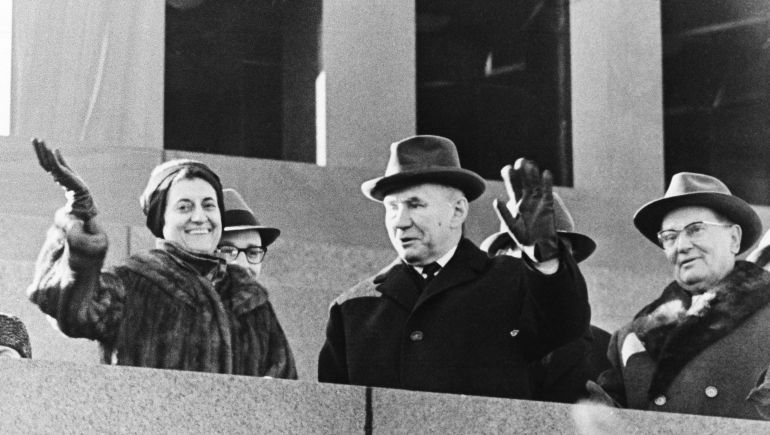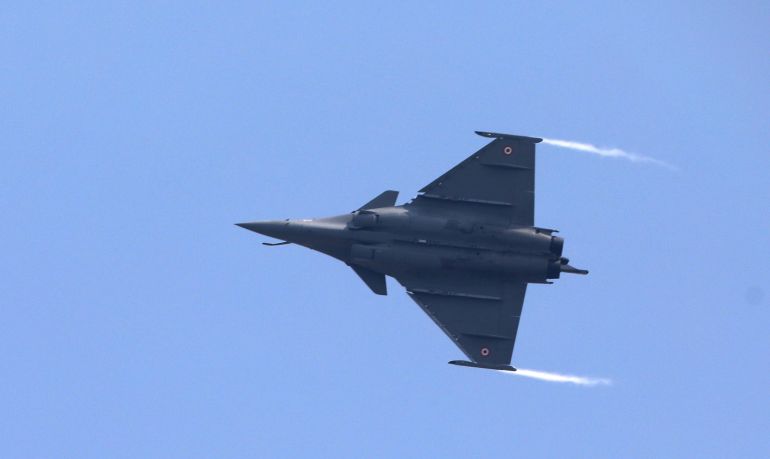As Russian tanks rolled into Ukraine in February 2022, marking the start of Europe’s biggest war since World War II, countries around the world came under pressure to choose between the Western-backed Kyiv on the one hand and Moscow on the other.
For more than 18 months since then, New Delhi has managed the tightrope balance between the two sides, carefully avoiding a direct condemnation of old friend Russia. But as leaders of the Group of 20 (G20) nations arrive in the Indian capital on Friday for their annual summit, Indian Prime Minister Narendra Modi might be forced to show his hand.
India and Russia are Cold War-era partners. After mediating peace between India and Pakistan to end their 1965 war, the Soviet Union deployed cruisers and destroyers in New Delhi’s defence after the United States sent a threatening warship into the Bay of Bengal during the 1971 war between the South Asian neighbours.
Historically, India has also depended on Russia for much of its defence arsenal, and for diplomatic cover at the United Nations Security Council. In return, India was the only South Asian nation to defend the Soviet invasion of Afghanistan in 1979.
More than four decades later, India is a rare major economy that has not openly criticised Russia for its war on Ukraine. Since the war started, it has also been the third-largest buyer of Russian oil, after the European Union and China, in defiance of Western efforts to curb those sales to limit President Vladimir Putin’s war chest.
But winds of change appear to be blowing. India has started to become more outspoken about the war in Ukraine. In recent years, it has pared back its defence purchases from Russia, turning, instead, to the US, France and Israel. And the price of Russian oil has risen, making it less lucrative to buy for India. Meanwhile, Putin has decided to skip the G20 summit while all Western leaders, including US President Joe Biden, are attending.
So, is India slowly drifting away from Russia? And what could that mean for the global order?
The short answer: India is unlikely to formally break up with Russia anytime soon. But some experts warn that their friendship has grown into a liability for New Delhi’s geopolitical ambitions, including as a trustworthy peacemaker in the current war in Ukraine. And the trajectory of the India-Russia relationship is clear: It is in steady decline, while the Modi government has bolstered ties with the West.

‘Legacy relationship’
Forged during the Cold War, the modern friendship between India and Russia has continued since the collapse of the Soviet Union in 1991. If Modi’s government has refused to join Western sanctions against the Kremlin over the war in Ukraine, there is a history behind that decision: Russia opposed sanctions imposed by the US, Japan and a few other countries on India following New Delhi’s 1998 nuclear tests.
Nearly 70 percent of combat aircraft used by India’s air force and navy, 44 percent of the country’s warships and submarines and more than 90 percent of the army’s armoured vehicles are of Russian origin. The two worked together to create the BrahMos supersonic cruise missile, which they are now exporting to the Philippines. In 2012, India leased a nuclear submarine from Russia.
Russia has also been a steadfast partner of India’s civilian nuclear energy programme, helping New Delhi build the Kudankulam nuclear power plant – the country’s largest – in the southern state of Tamil Nadu. That nuclear complex is now being expanded.
While India’s ties with the West have strengthened dramatically over the past three decades, and Russia’s global clout has weakened, New Delhi has been careful to not antagonise Moscow.
“Our relations with the US and other Western countries have gone through a transition. They’ve become closer and more strategic in character, but not at the expense of diluting our relationship with Russia,” said Ashok Kantha, a former secretary in India’s foreign ministry, where he oversaw relations with 65 countries. “It’s a legacy relationship, and that factor of being supportive of each other has not changed.”
And at least initially, the war in Ukraine appeared to have given a fresh boost to that old friendship. India bought almost no oil from Russia before the war. But Moscow became among its top suppliers after the war triggered Western sanctions against Russia, which started offering discounted oil to friends like India. The US and the EU also imposed a price cap of $60 per barrel on Russian oil – ships of G7 nations ferrying costlier crude could be exposed to sanctions.
Since the start of the war, India has imported oil worth a little over 34 billion euros ($36.7bn), as per data from independent research organisation Centre for Research on Energy and Clean Air. In 2023, India has become the largest buyer of Russian seaborne crude, accounting for 38 percent of these exports.
“This is part of India’s strategic autonomy, where it is pursuing policies that are in keeping with its national interests and not as camp followers of any country,” said Kantha.
Yet, hard data and the realities of geopolitics suggest that India’s perceptions of its national interests might be changing.

Shifting sands
While Russia remains India’s largest supplier of defence equipment by far, its sales have dropped around 65 percent in the past decade to $1.3bn in 2022, according to the latest data available with SIPRI, an independent institute that tracks arms trade.
At the same time, India’s defence purchases from the US have jumped almost 58 percent to $219m, albeit that is a much smaller figure than its purchases from Russia.
Similarly, India’s purchase from France has gone up some 6,000 percent to a peak of $1.9bn in 2021 while deals with Israel are up a little over 20 percent to $200m.
To be sure, Russia’s share remains substantial.
“In any case, we can’t taper down collaboration within a short period of time,” Kantha pointed out.
And even if the US and France gradually reduce India’s military dependence on Russia, New Delhi will not call itself an “ally” of the West, said Hari Seshasayee, visiting fellow at the Observer Research Foundation, a New Delhi think tank, and an Asia-Latin America expert. This is because “India cannot afford to take sides” and does not want to be distracted from its domestic priorities, he said.
Still, it is not just military hardware where the relationship is shifting. After initially refusing to speak much on Russia’s war in Ukraine, Modi in September told Putin that “today’s era is not an era of war”, in public comments captured by cameras.
Since then, Modi has repeatedly pitched India as a potential peacemaker, speaking multiple times with both Putin and Ukrainian President Volodymyr Zelenskyy, whom he also met in May on the margins of the G7 summit in Japan.
But given its historical ties with Moscow, and its recent oil purchases, New Delhi has struggled to gain credibility as a neutral mediator, said Seshasayee. Others have tried to take up that role, including Turkey and Saudi Arabia.
Oil is turning out to be a slippery glue, too.
While refiners in India have been snapping up Russian crude since the war began, those purchases have started to peter off.
In July, India’s imports of Russian crude fell by 8 percent in volume terms due to a seasonal decline in demand in the monsoon season and annual maintenance at refiners, as per CREA data. That apart, discount on Russian oil is down by as much as 87 percent by some accounts to $4 per barrel from $25-$30 per barrel on the back of higher prices of its flagship Urals blend and new customers.
That has made it a less attractive option for New Delhi to continue buying from Moscow, especially as it had been forced to make some of the payments in dirhams and yuans, the latter, especially, being an unpalatable option for its given tensions with Beijing.
In August, India’s purchase was down 13 percent from the previous month, albeit still a hefty 63 percent higher than a year ago.

‘Russia is India’s past’
Happymon Jacob, a foreign policy analyst and associate professor of disarmament studies at New Delhi’s Jawaharlal Nehru University, described India’s hunger for Russian crude as “an opportunistic purchase”, especially as it, as a developing country, needs various sources in its energy basket.
But “energy purchase is not indicative of any great upswing of relationships”, he added.
What matters, said Jacob, are people-to-people relations and bilateral investments, both of which are “hardly” there.
As per Indian government data, around 14,000 Indians live in Russia, including 4,500 students. The data on the number of Russians living in India was not available, but Jacob estimates it to be “much less” than that. By contrast, 4.9 million people of Indian origin live in the US. Another 2.8 million live in the United Kingdom and the EU.
“How many Indians speak Russian today? Very few. Ask young Indians if they have any fascination for Russia. The answer is no,” he said. “Russia is India’s past. Europe and [the] US are India’s future.”
Similarly, bilateral trade between Moscow and New Delhi for the financial year ending March 2023 was $49bn, a third of India’s trade with the US at $129bn – and that is after unprecedented oil imports from Russia.
While India has historically been wary of how much it could trust the US, given Washington’s old friendship with its arch-enemy, Islamabad, the fact is that “Russia’s ability to stand as a partner has reduced dramatically”, Jacob said.
One key reason for that is the rapid strengthening of Russia’s relationship with China, which India views as a major strategic threat.
Every weapons system that Russia sells to India, it now also sells, or can sell, to China. One example is the S-400 missile defence system, which Russia has sold to both China and India. This system is a part of New Delhi’s security umbrella for the G20 summit.
“The Indian desire to checkmate China using Russian help has not gone anywhere,” Jacob said. “Put differently, Russian ability to be a mediator between China and India is extremely limited.”
Moreover, Indian interests are now geopolitically being drawn to the Indo-Pacific region, where it sees Beijing as its prime competitor. There, it is collaborating with powers like Australia, France, Japan and the US.
“In that sense, Russia is no more a natural partner for India. It’s not that there’s bad blood between the two, but now there are other realities,” Jacob said.
Source : Aljazeera















